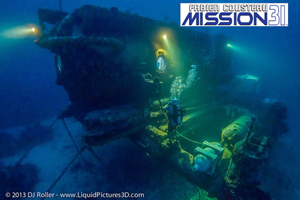Guest post: An underwater science ‘Mission’

This guest post is written by Lori Lennon, communications coordinator and senior writer in the College of Science.
You could say I am a little biased, but the scientists here in the College of Science at Northeastern University are doing some amazing research, which has offered up some pretty cool opportunities for them.
Earlier this month, professors Mark Patterson (Department of Marine and Environmental Science and Department of Civil and Environmental Engineering) and Brian Helmuth (Department of Marine and Environmental Science and School of Public Policy and Urban Affairs) announced they would be science advisers to a team of aquanauts led by Fabien Cousteau, the grandson of the famous Jacques Cousteau, called Mission 31. (Seriously, how many people can say that?)
THE MISSION
Fabien and a team of researchers will spend 31 days underwater exploring the environmental impacts of climate change and how it is changing coral reefs, pollution, and overconsumption problems. The team will be stationed in Aquarius, an underwater facility where scientists live and work on the coral reef. While surface-based scuba divers are limited in the amount of time they spend on the bottom due to the build-up and release of gases in the body, Aquarius aquanauts instead allow their bodies to become “saturated” with Nitrogen. This provides almost unlimited time on the bottom, but also the problem that they cannot surface until the end of the mission. Aquarius is owned by the National Oceanic and Atmospheric Administration and is positioned 63 feet below sea level, nine miles south of Key Largo, Fla. (Want to see what Aquarius looks like? Check it out.) This station is the only undersea marine habitat and lab devoted to scientific research in the world.
The team will launch saturation training in mid-September and will submerge on Sept. 30. The first full day on Aquarius will be Oct. 1.
Besides the obvious cool factor of Fabien Cousteau leading the endeavor, Mission 31 will be the longest underwater mission ever hosted by Aquarius. The team will spend one more day and go 30-feet deeper than the mission led by Cousteau’s legendary grandfather 50 years ago.
NORTHEASTERN+MISSION 31=AWESOME
Here’s where Northeastern comes into play. Mark Patterson and Brian Helmuth will be science advisers to Mission 31 and help direct its research projects. In fact, the data collected will help advance Northeastern’s Urban Coastal Sustainability Initiative. The College of Science held a conference to kick off this initiative last month that included a lecture by legendary explorer Sylvia Earle, who will also take part in Mission 31 as VIP visitor. If you missed it, or want to learn more, we’ve posted the video from her talk here.
Needless to say, both Patterson and Helmuth are looking forward to this project. “I am excited by the unprecedented length of the mission, over which they will gather data for Northeastern,” said Patterson, who will be onsite three times during the duration of the mission, with several planned visits inside for outreach events, some involving the Northeastern community.
“Living underwater allows scientists to complete research that normally would requires many months of surface diving,” Helmuth said. “This is really the only way for a scientist to literally be immersed in the natural environment long enough to get a feel for how this amazing ecosystem works, and to genuinely understand just how much we humans are changing it.”
TAKING EXPLORATION INTO THE CLASSROOMS
In addition to amazing research, there is a valuable education factor to this project. Students in classrooms all over the world will be able to watch the explorations first-hand through Skype and Ustream, and the Weather Channel will provide ongoing coverage of the mission. This will give many students the opportunity to experience the ocean and interact with researchers like they never have before. “One of the most rewarding aspects of working with Aquarius is an opportunity to share the excitement with school children,” Helmuth said. “During a mission in 2000, we stayed in constant contact with five classrooms over email and video link, and in 2001 we trained a third grade teacher to use mixed gas diving so that she could conduct research with us. Over 10 years later, we still hear from some of the kids about how much it changed their understanding of the ocean.”
UNCOVERING THE OCEAN’S BEAUTY
In a recent release, Fabien Cousteau expressed his excitement to not only build upon his grandfather’s legacy, but to also show the world the beauty and fragility of the ocean. “Using the latest camera technology, we will be able to show the world every second of Mission 31 in unedited, real-time and I believe it’s going to shock people. We have explored less than 5 percent of our ocean realms; there’s so much more to be discovered.”
You can follow the mission on Twitter (@Mission_31), on Facebook, and through the Mission 31 website. We here in the College of Science will also be providing updates on Patterson and Helmuth through our own social media channels.
Stay tuned!






